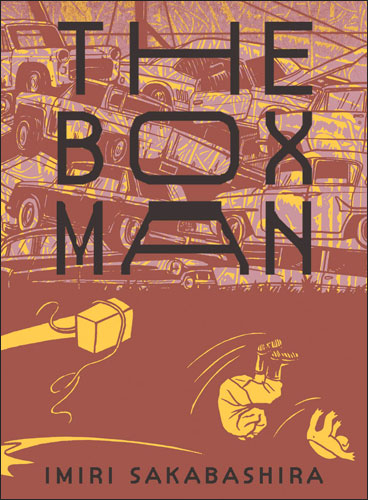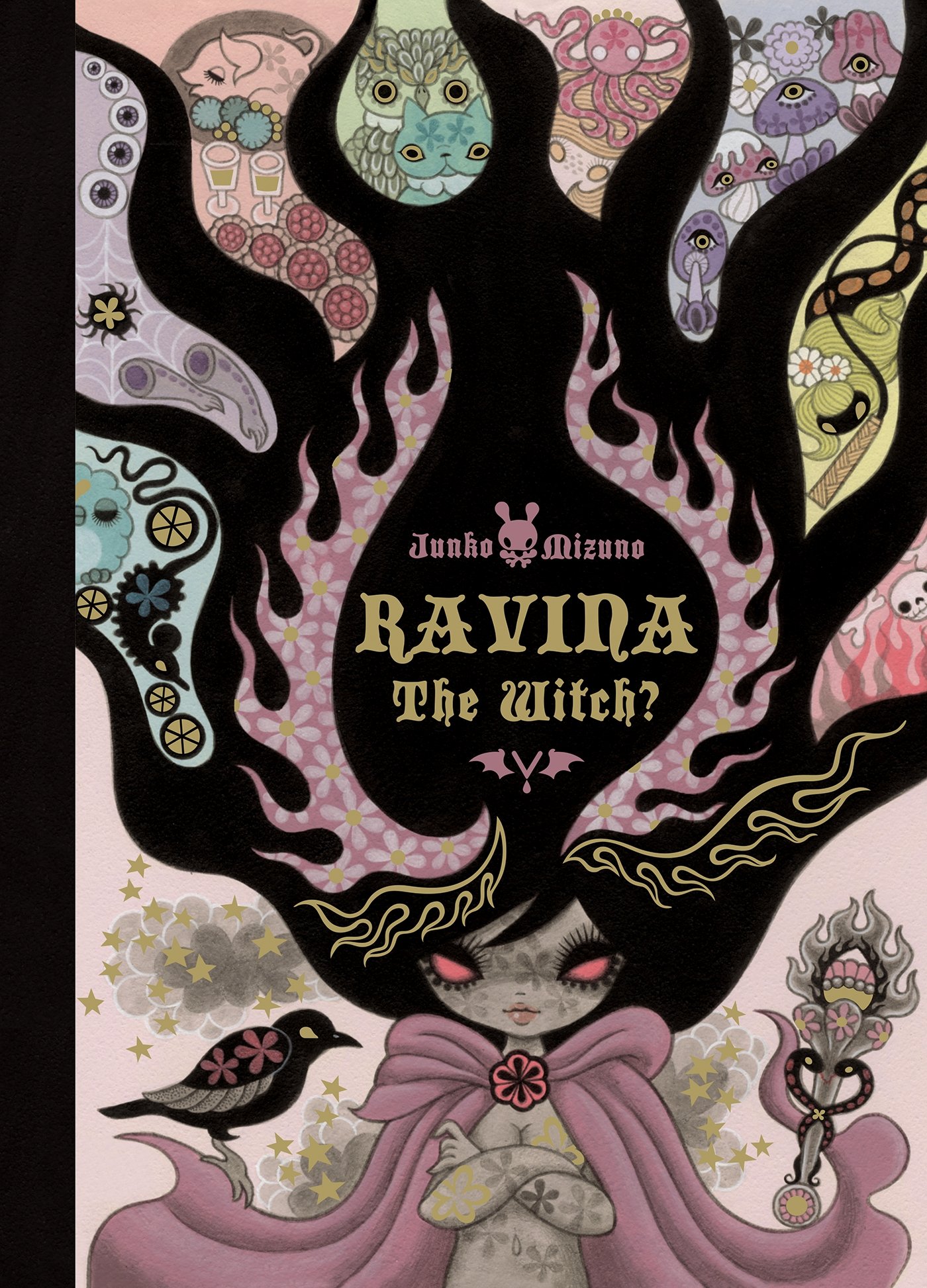A few weeks ago, Salon columnist Laura Miller offered a radical suggestion for bookworms: make a New Year’s resolution to read outside your comfort zone. Though I like to think my manga-reading habits are broad and adventurous, I cheerfully acknowledge that there are certain categories that I strenuously avoid. All things mecha, for example: I lost interest in Bokurano Ours when I realized that it would be a grim variation on the standard children-piloting-giant-robots scenario. Underground manga, for another: I know as a manga critic I’m supposed to think Short Cuts and Mr. Arashi’s Amazing Freak Show are brilliant, sophisticated, daring, etc., but their disturbing imagery made me kind of queasy. These are blind spots, I know, so I decided to address my hang-ups head-on by making 2010 The Year of Reading Everything.
The Box Man (Drawn & Quarterly), my first experiment, reminded me why I usually shun books that purport to “push even the limitless boundaries of the comic book medium”: that phrase seems to be a coded way of saying “weird stuff that might strike normal folk as ugly, pointless, or offensive.” And indeed, The Box Man certainly challenges the “boundaries of the medium,” if not the boundaries of good taste: the art has a studied naivete, there’s no real plot to speak of, and there are numerous images that verge on tokusatsu porn. (More on that in a minute.)
The Box Man is a collection of trippy set-pieces connected by a baldly literal conceit: a journey. The book opens with a man in sunglasses and his companion, a cat with a carapace, loading a box onto the back of a scooter. The two then set off into the night, encountering goons, wrestlers, aliens, two-headed pigs, VW-sized protozoa, and lounge singers in the back alleys and sewers of an unnamed city. Though they’re chased and menaced throughout the book, there isn’t an obvious rationale for any of the activity; it’s action for action’s sake. The lack of plot isn’t fatal, but when the goings-on include wrestling matches that pit monsters against humans in grotesquely sexual ways… well, call me a nice Irish Catholic girl, but it seems like those sequences ought to serve some clear purpose. (They don’t.) Even my attempts to contextualize these images within the greater history of shunga print-making only went so far; yes, I can see these images’ relationship to, say, The Dream of the Fisherman’s Wife, but no, I’ve never had the urge to frame something like that and hang it over my sofa, nor do I find the Creature Double Feature angle a playful update on the tradition.
It’s a shame that these images take up so much space in the middle of the book, as it’s obvious that creator Imiri Sakabashira has a fertile imagination. Sakabashira loves to take the familiar and make it strange, grafting a human head onto a crab’s body, for example, or stocking the local fish market with the kind of toothy critters normally found miles below the ocean’s surface. It’s also undeniable that Sakabashira has serious drawing chops; his streetscapes have a vital energy and specificity that’s missing from a lot of manga, filled with meticulously-drawn signs, clothes lines groaning under the weight of laundry, weedy lots, and tangled power lines.
Yet for all the obvious craft that went into The Box Man, I could never quite abandon myself to the artwork. I’ve always found surrealism one of the shallower manifestations of modernism, an overly intellectualized attempt to repackage Romantic interest in dreams, the supernatural, and the occult as a penetrating critique of positivism. I would never deny the artistry of Dali or Ernst, but I would never put their best work on par with, say, Picasso’s, as those melting clocks and fireside angels always seemed more like stunts than meaningful statements about the modern condition. The same problem bedevils The Box Man: it’s vivid and hallucinatory and nightmarish, yet in the end, all that furious activity doesn’t signify very much.
THE BOX MAN • BY IMIRI SAKABASHIRA • DRAWN & QUARTERLY • 124 pp. • NO RATING (BEST SUITED FOR MATURE AUDIENCES)




Kris says:
As a reviewer, it’s probably important to branch out like that. As an individual, while it’s still probably important, you’re not under any obligation to not be an old coot about it. I rarely venture out of my literature comfort zone, which is basically: Tolkien, and 18th & 19th century European literature (and, I say that, but what I mean is English and French, like Dickens and Hugo…and not Dostoyevsky). It’s rare that something more modern, like Memoirs of a Geisha or Everything Is Illuminated, slips in there. And there certainly has never been any Stephen King or Michael Crichton.
I suppose when you try to branch out, and you’re greeted by something like this, it’s a bit discouraging.
What exactly is tokusatsu, by the way?
Katherine Dacey says:
I tend to more adventurous with manga than literature because of the time involved: I can polish off a tankubon in about 20-30 minutes, but even the shortest Muriel Spark novel takes a few hours, so I stick to what I think I’ll like. I also skip stuff that reads like TV or movies; manga generally does the same thing more effectively and efficiently than prose alone, IMO.
I’m not sorry I read The Box Man. Even though it wasn’t my cup of tea — to say the least! — it definitely challenged my definition of what manga is. That’s a good thing, because it keeps me (and, by extension), my writing from getting stuck in a rut. I could be very, very happy reviewing nothing but titles from Viz’s Signature line.
As for tokusatsu, here’s the Wikipedia entry: http://en.wikipedia.org/wiki/Tokusatsu. Generally speaking, it’s a catch-all term for Japanese movies and TV shows with a lot of special effects, generally with monsters, robots, and/or superheroes. A lot of the character designs in The Box Man look like grotesque parodies of stuff found in Gamera and Kamen Rider.
Jade says:
I haven’t been that impressed with underground manga either, but I think the big problem there is having trouble kenning out the intent. Is the Push Man and Other Stories a scathing indictment of misogyny inherent in Japanese society from that period or are they just Tatsumi’s personal revenge fantasies? It’s just hard to understand and be able to pull together a reaction to the experiences and interpretations when the focus of those experiences and interpretations, Japanese society, isn’t shared.
Then again, underground anything isn’t so much about what someone is saying so much as the who behind the saying of it. It’s easy to see how so many underground books can get a bye, especially when not knowing what exactly they’re on about is so often confused with irony.
Great review though! It was a nice mix of your own reaction and objective judgements; it must have been hard to juggle.
Katherine Dacey says:
Thanks for the feedback, Jade! I’m sure I barely scratched the surface of The Box Man, which is why I focused mainly on my own reaction to it.
I haven’t known what to make of Tatsumi’s short story anthologies, either — I found them grim, angry, and pointless. I also wasn’t sure if the horrible treatment of women was supposed to be realistic or was a reflection of how Tatsumi himself felt. Don’t know if you saw Bill Randall’s review of Good-Bye from a few weeks ago, but I think it summarizes how I feel about a lot of “underground manga” that’s been translated for the US market.
Krill says:
If you read the interview in the back of Push-Man, tatsumi says he got a lot of his stories from police reports and newspaper articles. Based on reading A Drifting Life he has always struck me as a very objective kind of author. As such, I would be skeptical that the stories represent revenge fantasies of his.
Katherine Dacey says:
Thanks for another perspective on Tatsumi’s work, Krill. Sounds like that interview provides some valuable context for his short stories, so I’ll have to check it out.
As a woman, I find many of Tatsumi’ stories difficult to read, given the degrading treatment his female characters endure. I have a hard time teasing out whether the characters’ treatment reflects an objective perspective — Tatsumi holding up an unflattering mirror to society — or his own attitudes towards women — it’s one of the main reasons I’ve never attempted a review of Abandon the Old in Tokyo, The Push-Man or Good-Bye. I definitely found A Drifting Life much more accessible.
Jade says:
Right, I wouldn’t want to accuse Tatsumi of anything, the work should be taken on its own. Unfortunately, our western underground comics culture is heavily linked to autobio pieces with only a thin veneer of detachment. So looking at Tatsumi’s work, based on our own underground comic culture, we have to ask whether or not he’s the Bob Crumb of Japan when, in all actuality, Push Man is a comic extension of noir films like ‘M’.
Bill Randall brings up a decent point though. Red Snow features a lot of the same degradation of women and disturbingly, children, but it’s done in a way that I don’t question the artist’s motives. On the other hand, Tatsumi was rebelling against manga conventions and trying to embody a certain revolutionary crassness of the time period, so I don’t think the lack of subtlety can be written off. Contemporary underground books are also working against similar conventions, we just don’t always know the full story.
On the other side of this five or six-sided coin, a story may just be plain awful to read no matter how brilliant it is.
Bill Randall says:
Hey, Katherine, thanks for the link. Reading this sent me fishing around on Sakabashira again, and I think you’ll agree with the Japanese Wikipedia article: “In his works, story and content, purpose and climax… don’t exist… for the reader it’s like sightseeing in a foreign country, or a dream.” For me, it’s the pleasure of spectacle, like my first time in Bangkok, alone, illiterate, no one knowing where I was, awestruck by the decaying cityscape, wondering if the cabbie would drug me for a kidney.
That said, I think Sakabashira’s hilarious. He’s dumping his childhood viewing habits (kaiju) in the godowns, a post-bubble update on 60s kid-pop optimism. Hataraku Kappa is his best all-around work, a playful quest that could sit with Yo Gabba Gabba if I was babysitting. I would have picked it for a first translation, but no one asks me these things. They don’t ask me to babysit, either.
I haven’t read D&Q’s version, though, so they could have selected stories to fit the UG cliches that seem popular here. Nemoto & all that.
@ Jade~ Red Snow reads easier on the sex & violence because it’s (like) folklore, right? That and the fact that Katsumata’s twice the artist Tatsumi is. I do think transgressive works travel poorly. Without the context you end up comparing it to patterns in your own culture, which may not apply. The context contains and defines the transgression whole.
While I’m here, an earlier post with a link to his photography: Sakabashira Imiri & whatnot The first image at least points to the comedy.
Katherine Dacey says:
You’re welcome, Bill — sorry your comment got trapped in spam-filter purgatory for so long. It must be all those links to usurious mortgage sites!
Seriously, though, it’s the sexual content of The Box Man that I found most off-putting. Sakabashira is hardly the first artist whose work puts me in the uncomfortable space of saying, “Yes, I see the artistic merit, but jeez… why did he have to do THAT to his female characters?” I’ve had to the same reaction to many American creators’ work, too. R. Crumb is a great example of someone whose talent and anti-establishment stance I can get behind, but whose imagery sometimes touches raw feminist nerves.
Thanks for all the links. I will do some surfing/reading this weekend.